- Prediction of the strength of self-compacting cementitious mix with glass fibre using machine learning
Balasubramaniam Na,* and Padmanaban Ib
aAssistant Professor, Department of Civil Engineering, Jansons Institute of Technology, Coimbatore, India
bProfessor, Department of Civil Engineering, Sri Krishna College of Technology, Coimbatore, IndiaThis article is an open access article distributed under the terms of the Creative Commons Attribution Non-Commercial License (http://creativecommons.org/licenses/by-nc/4.0) which permits unrestricted non-commercial use, distribution, and reproduction in any medium, provided the original work is properly cited.
Self-compaction concrete possesses non-segregation characteristics and the ability to flow through the heavily reinforced section with required viscosity. The addition of fibres in SCC enhances the strength of the concrete and reduces the brittle nature. Many such fibres like plant fibres, basalt, the glass was used in SCC as single reinforcement or hybrid reinforcement. This article focuses on the prediction of the strength of SCC infused with glass fibres. The input data was derived from various kinds of literature arranged in the format of nine input variables viz., cement, coarse and fine aggregate, water to powder ratio, superplasticizer, viscous modifying agent VMA, fly ash, GGBS/silica. A dataset of 128 samples collected was used to predict the output variables such as compressive strength and flexural strength of SCC with glass fibres. The mathematical modelling was deployed using ANN in MATLAB. The output of the developed model was assessed through RMSE (root mean square error) and R2 (regression coefficient). It was concluded that the model can further be utilized to predict the strength (compressive and flexural) of SCC concrete
Keywords: Self-compaction concrete, fibre, glass, Artificial Neural Network ANN, MATLAB
Concrete has become inevitable material in everyday life and the per capita consumption has raised to a greater extent. With its diverse applications, different forms of special concrete-like self-compaction concrete, self-consolidating concrete are evolving to meet out the demands of the industry. Self-compaction concrete has the ability to flow and fill up the formwork without any vibration and also resistance against segregation. The high workable mix of SCC increases the speed of construction and reduces the manpower requirement. The production and characteristics of SCC depend mainly on mix proportioning and workability of the concrete mix [1]. The rheological characteristics and strength parameters should meet the prescribed limits to achieve SCC. The high workability of SCC was achieved through reduction of water content/coarse aggregate, use of superplasticizer/viscous modifying agent (VMA), and increase in powder content in the form of fly ash, silica fume, GGBS [2] and rice husk ash [3]. The SCC mix was evaluated based on an experimental procedure such as slump test, L-box test, U-box test, V-funnel test, and J-ring test [4].
Construction technology has taken a new shape after the introduction of fibres in concrete. The inclusion of fibres in concrete leads to an increase in strength, durability, impact resistance, and ductility and also controls the bleeding and cracking of fresh and hardened concrete respectively [5, 6]. SCC concrete was reinforced with different types of man-made fibres viz., steel [7,8], basalt [9-11], and natural fibres viz., banana [12] as single reinforcement. Some of the combinations of hybrid reinforcement in the form of Steel and carbon, steel and nylon, steel and polypropylene, steel and basalt, glass and polypropylene are also used in SCC.
Steel fibres are the most common fibre in the SCC. Many researchers have established the facts of utilizing steel fibres in SCC. Abdalla M. Saba et al. [13] have investigated SCC with different percentages of steel fibre (0.25, 0.50, 0.75, and 1.0%) and found that 0.5% steel fibres have attained desired workability and strength. Iman Ferdosian and Aires Camoes Center [14] revealed that 1% volume fraction of steel fibres in Ultra-High-Performance Concrete UHPC have increased the compressive strength, modulus of elasticity, toughness and flexural strength which was justified through the energy-absorption capacity of the specimens. Ni ng Li et al. [15] experimented self-compaction concrete for impact resistance with the addition of steel fibres (0.5%, 0.75%, 1.0%). The workability of SCC was decreased with an increase in steel fibre percentage and was maintained to have uniform workability by altering the superplasticizer dose. The impact resistance measured in terms of impact toughness index was higher for SCC with steel fibre compared to steel fibre reinforced normal concrete. Valeria Quiceno Pérez [16] utilized the digital image correlation technique for evaluating the mechanical properties of SCC with steel fibres. The inclusion of steel fibres has reduced the sudden failure by improving the mechanical properties after cracking load and preventing the propagation of cracks.
The most widely used fibre in SCC next to steel fibres are glass fibres. Mastali et al. [17] conducted experimental studies on the mechanical properties of SCC with recycled glass fibres (0.25%, 0.75%, 1.25%) extracted from unusable glass fibre reinforced polymers sheets. Scanning Electron Microscopic study was performed to explore the failure mechanism along with statistical and analytical investigation to establish a correlation between impact resistance and mechanical properties of concrete. The addition of recycled glass fibres improves the mechanical properties till the addition of 1.25%. However, SCC with 0.75% glass fibre exhibit good flexural strength and impact resistance. Yahya R. Atewi [18] carried out investigation on mechanical and permeability characteristics of SCC with nano-silica (2%, 4%) and glass fibres (0.35%, 0.7%, 1%, 1.5%). The authors have found that nano-silica can be used upto 2% and glass fibres at 0.7% based on the results of compressive strength, modulus of elasticity, tensile strength, fracture energy, permeability, sorptivity, and rapid chloride permeability test. Subhan Ahmad [19] examined the properties of SCC with glass and polyvinyl fibres in the ratio of 0.1%, 0.2% and 0.3% by volume. The inclusion of 0.3% glass and polyvinyl fibre has decreased the workability of SCC concrete. Based on the fresh and hardened properties of SCC, the addition of glass fibres (0.2%) shows good improvement over the SCC with polyvinyl fibres. Sivakumar [20] determined the influence of Metakaolin and glass fibres (0.1%-0.8%) through the rheological, mechanical and durability properties of SCC. The results revealed that the addition of glass fibres does not have a significant effect on compressive strength, a small increase in water absorption, reduced chloride permeability, increased tensile and flexural strength and optimum content was 0.8% of glass fibre. The waste glass in either form of fibre or powder, was also used in concrete for partial replacement of cement [21-23].
Artificial Neural Network and Machine learning models prove to be excellent techniques for predicting the non-linear behaviour of the concrete and optimization [45, 46]. The suitable mix design and prediction of strength and durability properties of SCC can be achieved through ANN modelling.
Marcello et al. [24] predicted the flexural response of fiber reinforced concrete by deploying 400 datasets using Five different ANNs. The input parameters were aspect ratio and volume fraction of fiber along with the compressive strength. The Bayesian regularization algorithm was used and achieved a regression fit value more than 92%. The best network was selected based on mean square error values. Venkata Subash et al. [25] modelled an ANN with 123 self-compaction concrete mixtures to predict the compressive strength and split tensile strength with input parameters such as cement content, water cement ratio, type and percentage of mineral/chemical admixture. Marquardt back propagation algorithm was used and achieved satisfactory statistical indicators such as mean square error MSE and correlation coefficient.
Paul O. Awoyera et al. [26] framed genetic programming GP and ANN model to predict the compressive strength, split-tensile and flexural strength of geopolymer SCC. The input parameters include the quantities of raw materials and fresh mix proportions. Good correlation was established between the experimental and predicted values for both GP and ANN. However, authors suggested GP as the preferred model based on the values of MSE and R2. Danial Nasr et al. [27] predicted the mechanical and durability properties of self-compaction concrete with natural Zeolite and nano-silica as partial replacement for cement. The input parameters considered for the construction of ANN includes the quantities of Portland cement, natural Zeolite, nano-silica, slump flow diameter, V-funnel flow time and age of concrete to predict compressive strength, water absorption, flexural strength, electrical resistivity. Feed-forward neural network was created to process the information in forward direction by varying the number of neurons in hidden layer. The correlation between experimental and predicted values assessed through correlation coefficients was higher than 0.94 for all the models.
Mahmoud Abu Yaman et al. [28] compared two different back propagation architecture developed through ANN for the two different datasets of self-compaction concrete mixtures. Slump and compressive strength of concrete are the outputs with quantity of basic ingredients such as input such as cement, fine and coarse aggregate, fly ash, water-cement ratio and superplasticizer. The correlation coefficient R2 was achieved between 0.63-1.0 for different models and authors have suggested ANN to be effective tool for proportioning self-compaction concrete. Hadi Mashhadban et al. [29] deployed an intelligent system through ANN and particle swarm optimization algorithm PSOA to generate a polynomial model for predicting steel and polyphenylene sulfide fibre reinforced SCC properties. It was concluded by the authors that ANN integrated with PSOA predicts the mechanical properties with accuracy and precision. Rafat Siddique [30] developed two ANN models to predict the 28 days compressive strength with six and eight parameters such as cement, sand, aggregate, fly ash, bottom ash water and water/cement ratio and, superplasticizer. The ANN model with six input parameters achieved correlation coefficient above 0.9 and proved that powder content (cement and fly ash) has maximum effect on the strength of concrete.
Many researchers have modelled the characteristics of SCC concrete with different mineral admixtures using ANN and machine learning techniques [31, 32]. However, computing the strength of SCC with the addition of glass fibres has not been explored.
Research Significance
Very few researchers have utilized glass fibres and fly ash for the production of SCC for investigating the strength and durability properties. But no researchers have modelled the strength characteristics of SCC with glass fibres. Hence this paper presents the results of an experimental investigation carried out on SCC with glass fibres and also developed an ANN model to predict the compressive strength and flexural strength using the NN tool in MATLAB.
Resources
OPC of grade 53 and fly ash (10%) was used as binder material for the preparation of SCC. Aggregates available in the vicinity were used as coarse aggregate CA and fine aggregate FA with a specific gravity of 2.68 and 2.67 respectively. The coarse aggregate size was varying between 10-12.5 mm and river sand conforming zone II as per IS 383 [33] was used as fine aggregate. Ordinary potable water, superplasticizer SP along viscous modifying agent VMA was used to obtain the desired workability. Cem-FIL high dispersion glass fibres with the characteristics as described in Table 1 were utilized in this study.
Mix proportion and casting
Various trial mixes were prepared as per EFNARC guidelines to arrive at the final mix proportion as tabulated in Table 2. Different fractions (0.1%-0.7%) of glass fibres were added in the designed mix by weight of total cementitious material and the quantity of each material utilized was is shown in Table 2. The mix designation GF0 refers to the normal SCC without the addition of glass fibres whereas GF1 denotes the SCC with 0.1% of glass fibre and GF5 represents the SCC with 0.5% of glass fibre content.
The casting process was initiated by adding fine and coarse aggregate into the pan mixer and made to revolve for 1 minute. The next step involved the pouring of 30% of the total required water with a revolving time of 2 min. The binding material was then added and mixed for about 2 min to obtain a homogeneous mixture. For NSCC mix, remaining water along with SP and VMA were added and allowed for 2 min mixing. For SCC mixes with glass fibres, the fibres are dispensed before the addition of remaining water, SP, and VMA and mixed for an additional time of 2 min.
Test methods
Fresh property of SCC
The preparation of self-compaction concrete mainly depends on its fresh properties. The fresh properties of self-compaction concrete were found using various tests such as slump flow, L-box, and V- funnel test as per BS EN 12350 [34]. The slump flow and T500 time are meant for assessing the flowability (filling ability) and rate of flow in the absence of obstructions. The time taken for the concrete to spread over a diameter of 500 mm is measured as T500 time. Slump flow is the average of the largest diameter and diameter measured at right angles to the largest diameter. L-box predicts the passing ability by allowing the concrete to flow through the obstructions (reinforcing bars) to fill up the horizontal part of the L-box. The blocking ratio (h2/h1) was measured by dividing the height of concrete at the end of the horizontal portion (h2) by the height of concrete at the beginning of the horizontal portion (h1). The viscosity and segregation resistance of the SCC was assessed through time taken for the fresh concrete to pour out of the V-funnel.
Hardened property of SCC
The compressive strength and flexural strength of the concrete mixes with and without glass fibres were found as per IS 516: 1959. The compressive strength test was performed on cubes of size 150 mm tested on a computerized testing machine of 200 T capacity after 28 days of casting, as shown in Fig. 1. The beam specimens of size 100 mm × 100 mm × 500 mm were tested for their flexural strength on a flexural testing machine of capacity 10 T after 28 days of casting and curing.
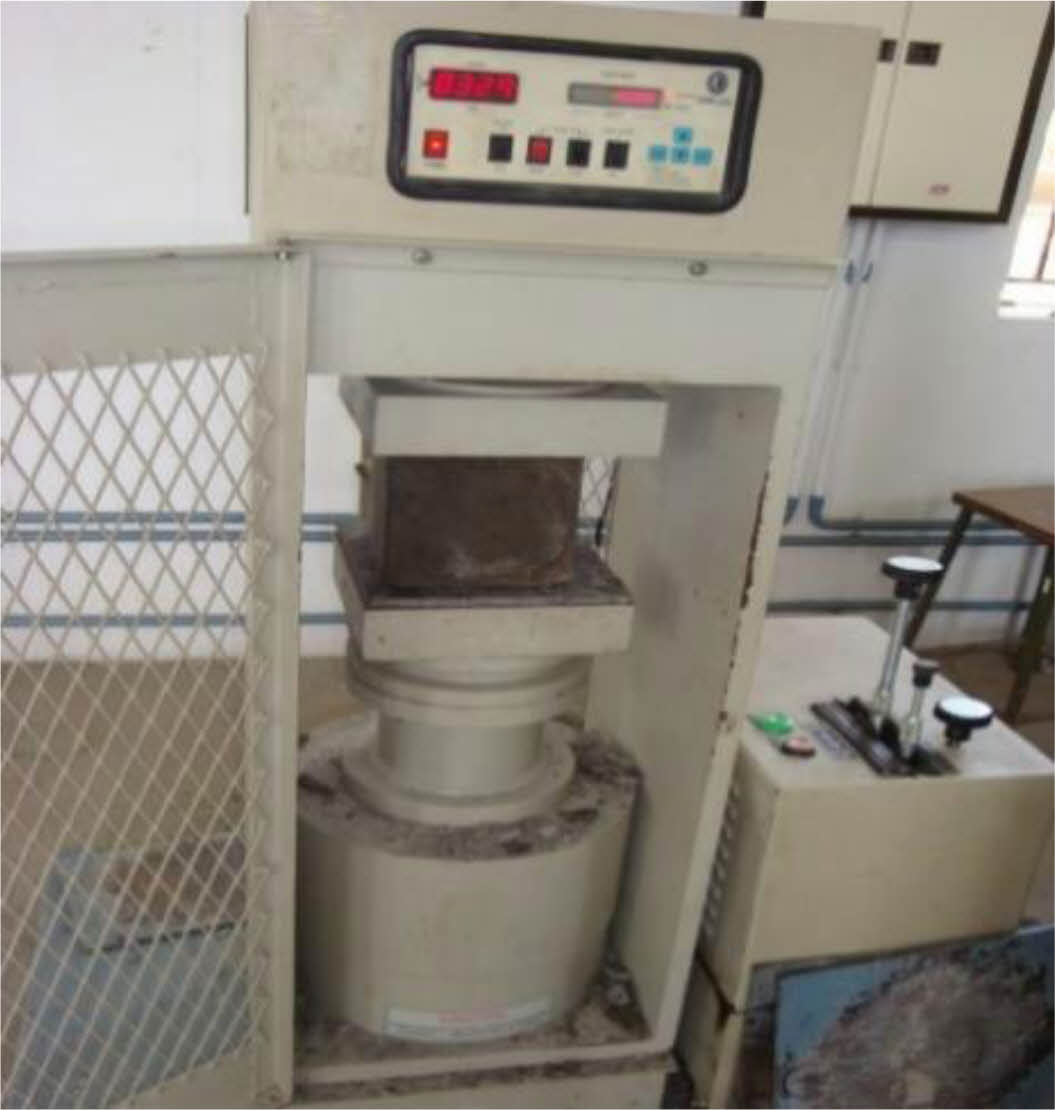
|
Fig. 1 Compressive test on cube. |
ANN Technique
Artificial Neural Network ANN resembles the functioning of our human brain consisting of interconnected neurons as their processing element. The neurons are arranged in layers and they can be skilled up to perform a certain task by regulating the weights or connection values between them. Fig. 5 shows the schematic picture of the ANN model. I1, I2 are the input elements with some weights such as W1, W2. Each input element is associated with the network through an activation function to estimate the output. The weights are transmitted to the network through signals and can be optimized through the training process. Any ANN model consists of two phases such as training and testing. During the training phase, the output is predicted through the input data, the difference between the measured and predicted output is reduced by adjusting the weights of each input.
Database
The database used in the neural network training was collected from various works of literature [35-44] utilized glass fibres in preparation of SCC are shown in Table 3. The data collected from several studies were grouped to finalize the input variables as follows;
Cement (kg/m3)
Fly ash (kg/m3)
Fine aggregate FA (kg/m3)
Coarse aggregate CA (kg/m3)
Water content (kg/m3)
Superplasticizer dosage SP (%)
VMA dosage (%)
Silica fume SF/GGBS (kg/m3)
Glass Fibre GF (%)
The input layer was consisting of nine variables as a processing unit whereas the output layer consists of two neurons viz., Compressive strength and Flexural strength at 28 days. Fig. 6 depicts the number of neurons available in the input, output, and hidden layer of the neural network architecture developed using MATLAB.
Training and testing of ANN
The training of the neural network was done through the data collected from the literature using the Levenberg algorithm with 9 input neurons and 2 output neurons. During the training phase, the network learns the data passed to it, modifies and updates the weights/bias to predict the strength characteristics of SCC with glass fibres. The testing phase was done using the experimental data of the current research work.
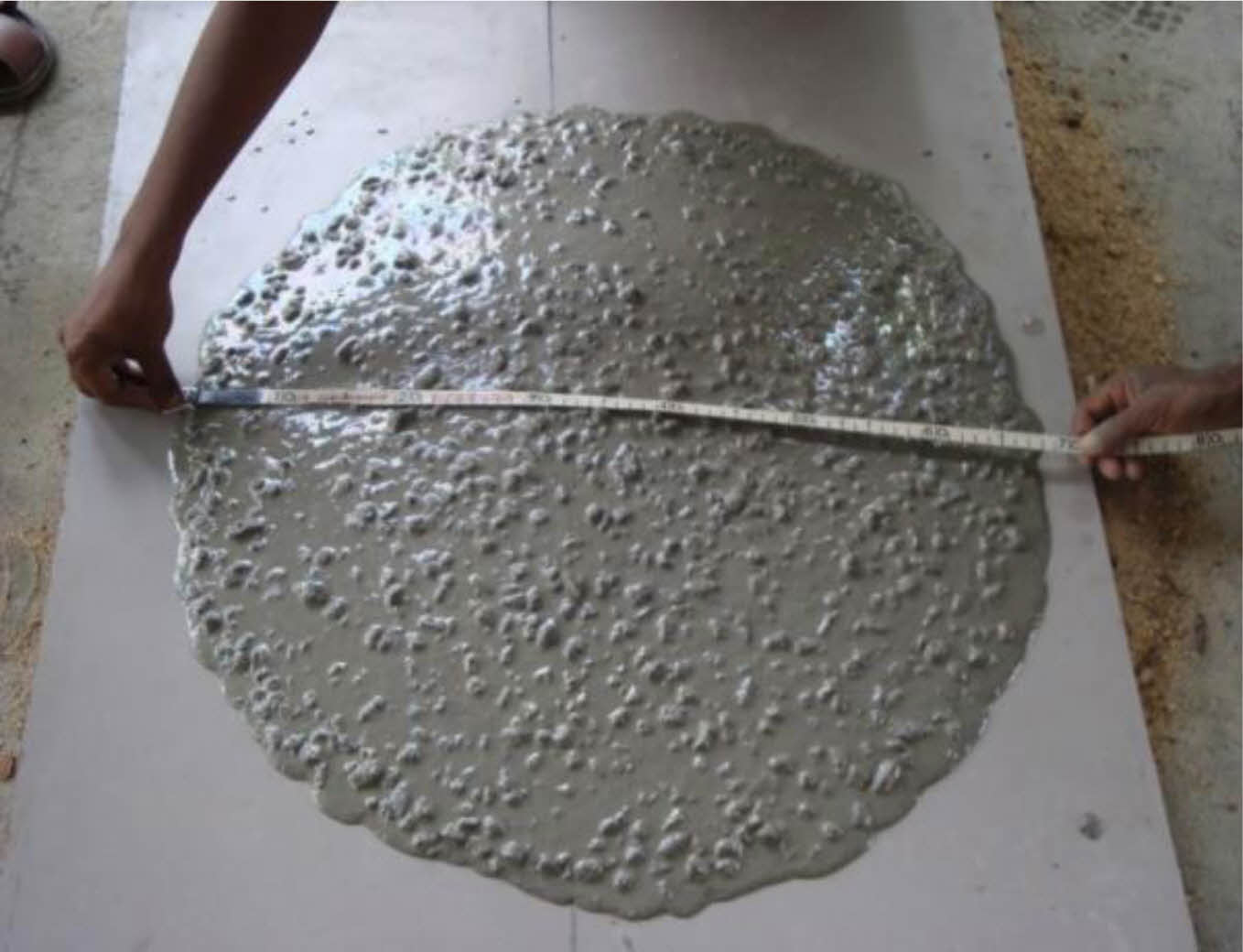
|
Fig. 2 Slump flow test |
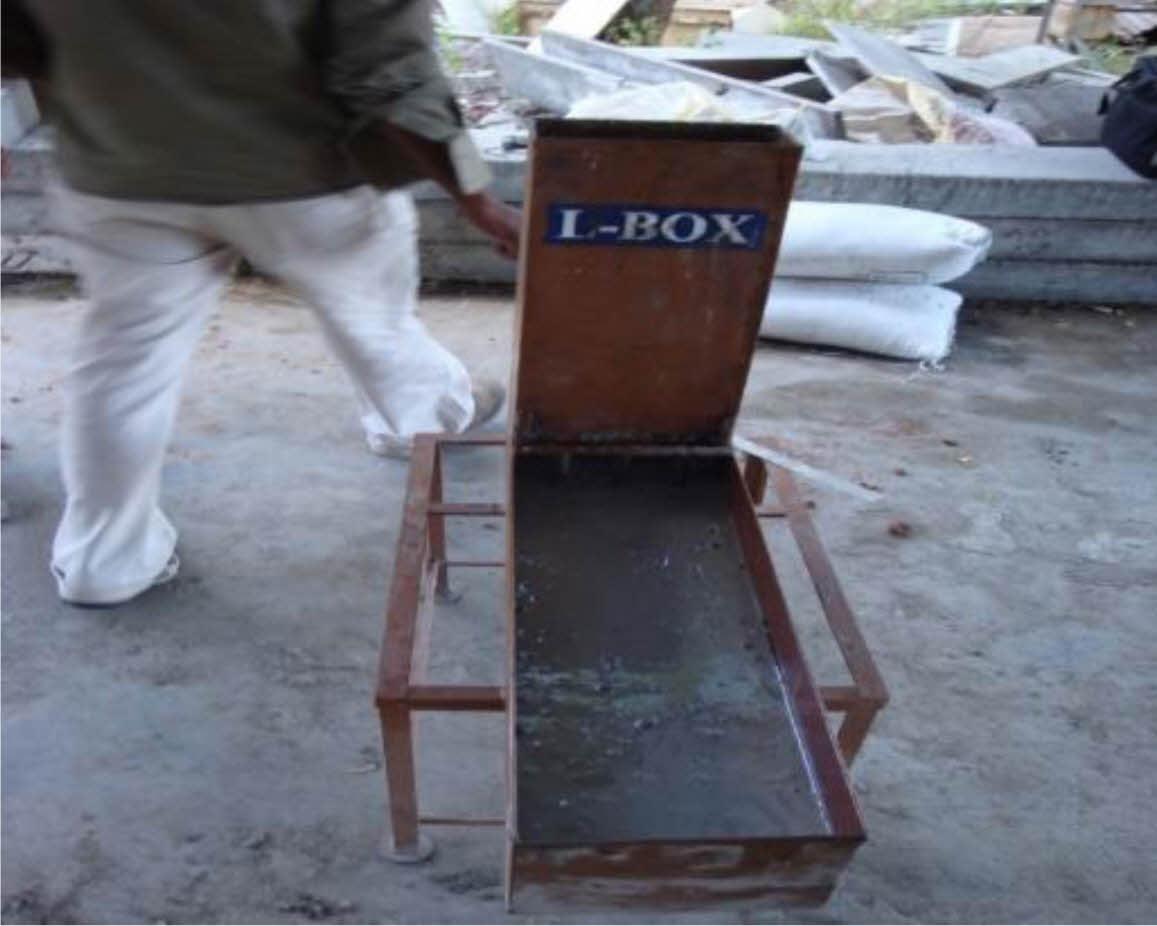
|
Fig. 3 L box test. |
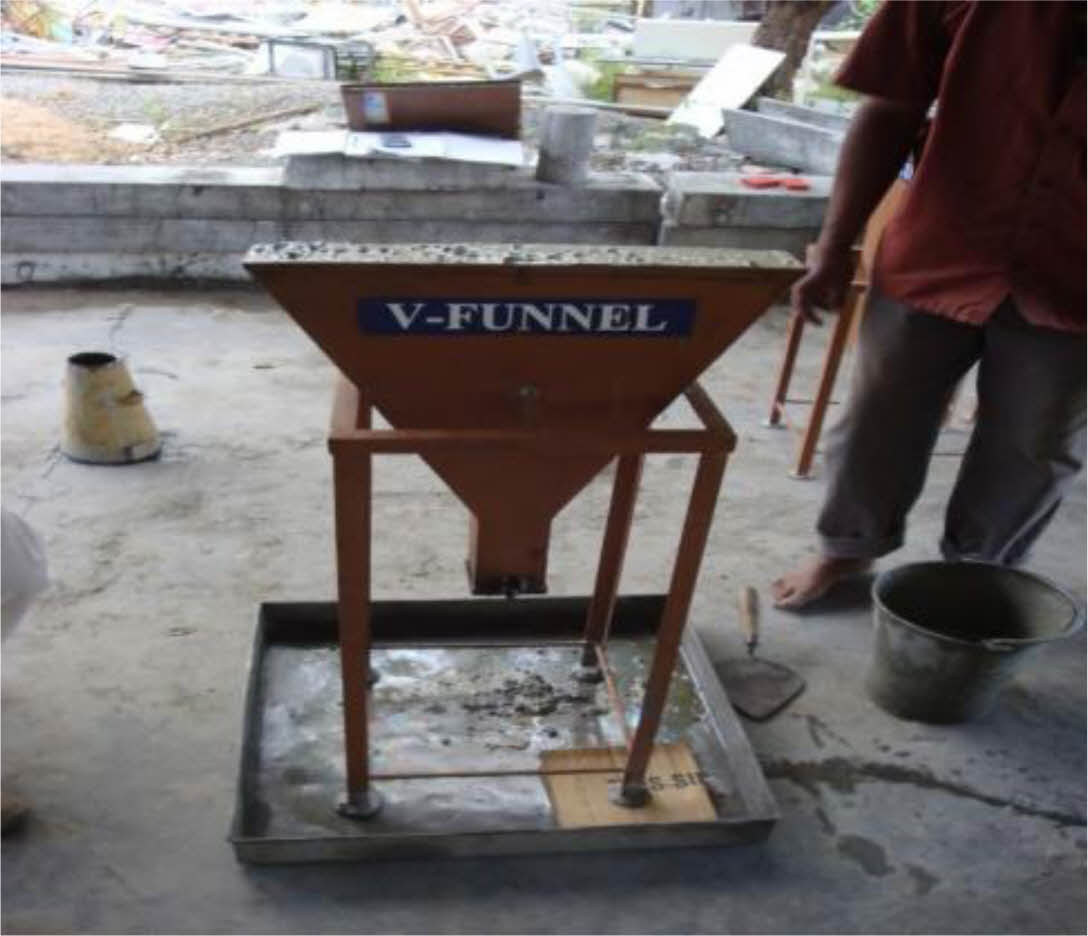
|
Fig. 4 V-funnel test. |

|
Fig. 5 ANN Schematic model |

|
Fig. 6 ANN architecture. |
Fresh property of SCC
The rheological properties such as slump flow, L-box, and V- funnel test were studied for glass-reinforced SCC concrete as shown in Fig. 2, 3 and 4. and the results were presented in Table 4 and Fig. 7. The slump flow and time required for normal concrete was 750 mm and 2.5 sec, respectively. With the inclusion of glass fibres from 0.1%-0.7%, the slump flow reduces from 745 mm-670 mm and T500 time increases from 2.8-4.5 as observed by several researchers [42, 38]. A similar trend is observed for L-box and V-funnel tests but the values attained as per the limits provided by EFNARC. The reason behind the reduction in flow property of glass fibre reinforced concrete is due to the increase in glass fibre content.
Hardened Property of GRSCC
The hardened property such as compressive strength and flexural strength of glass fibre reinforced concrete was tested as per IS 516 and the results are presented in Table 5 and presented in Fig. 8. The concrete without glass fibre achieved a compressive strength and flexural strength of 45.8 N/mm2 and 6.5 N/mm2. There was an increase in compressive strength by 1.74%, 14.4%, 19.4%, 21.17%, 16.5%, 9.38%, 2.4% for concrete with 0.1-0.7% glass fibre, respectively. Authors Y. R. Atewi [18], S. Ahmad [42] have reported a similar result, that there is an increase in compressive strength for SCC with glass fibres up to 0.7%. The flexural strength of glass fibre reinforced concrete exhibited 5.8%, 26.4%, 33.8%, 45.5%, 27.9%, 25%, 13.2% for 0.1-0.7% fibre content, respectively. The increase in flexural strength was in the range of 6%-14% as reported by [17] The strength showed an increasing trend for concrete with 0.1%, 0.2%, 0.3% and 0.4% and showed a decreased trend for 0.5%, 0.6% and 0.7%, but the values are still higher than the normal concrete. Maximum compressive and flexural strength was achieved for self-compaction concrete with 0.4% glass fibre. The decreasing trend in strength is attributed to the reduction in flowing capacity and clogging of fibres due to an increase in fibre content.
Fig. 9 shows the relation between compressive strength and flexural strength of glass fibre reinforced concrete. The regression coefficient (R2) was obtained as 0.91 (91.9%) which indicates that there is a good correlation between the predicted compressive strength and flexural strength of GFRSCC [25, 27].
ANN modelling of GFRSCC
A database of 128 experimental values was collected from various sources of pieces of literature. An ANN model was developed using Neural Network Tool box in MATLAB 2020 and trained according to the Levenberg optimization method. The validation of the proposed model was performed to check the accuracy through the experimental values conducted by the authors. The correlation co-efficient achieved for training, testing, and validation falls above 99% as shown in Fig. 10, which indicates that there exists a good relationship between the actual and predicted values during the different phases in ANN modelling.
The predicted compressive strength and flexural strength were then compared with experimental output through the statistical indicators such as R2 (Absolute fraction of variance), and Root Mean Square Error (RMSE) using the equation (1) and (2).

Where Opi – Output predicted from ANN, Oai – Actual output from literature and experiment, and n- the total amount of data.
The relation between the input and output variable can be well established through regression analysis. The efficiency of the regression analysis is evaluated through R2 and RMSE. The values of R2 and RMSE values of compressive strength and flexural strength are shown in Table 6. The R2 value of the model gives the proportion of variance in the output variable whereas RMSE provides the average distance between predicted and experimental values. The R2 value for experimental and predicted compressive strength and flexural strength was achieved as 93% and 94% respectively, which reveals a good correlation as shown in Fig. 11 and 12. The RMSE values are 3.53 and 0.32 for compressive strength and flexural strength, which indicates that the ANN model developed was able to predict flexural strength with more accuracy than compressive strength.
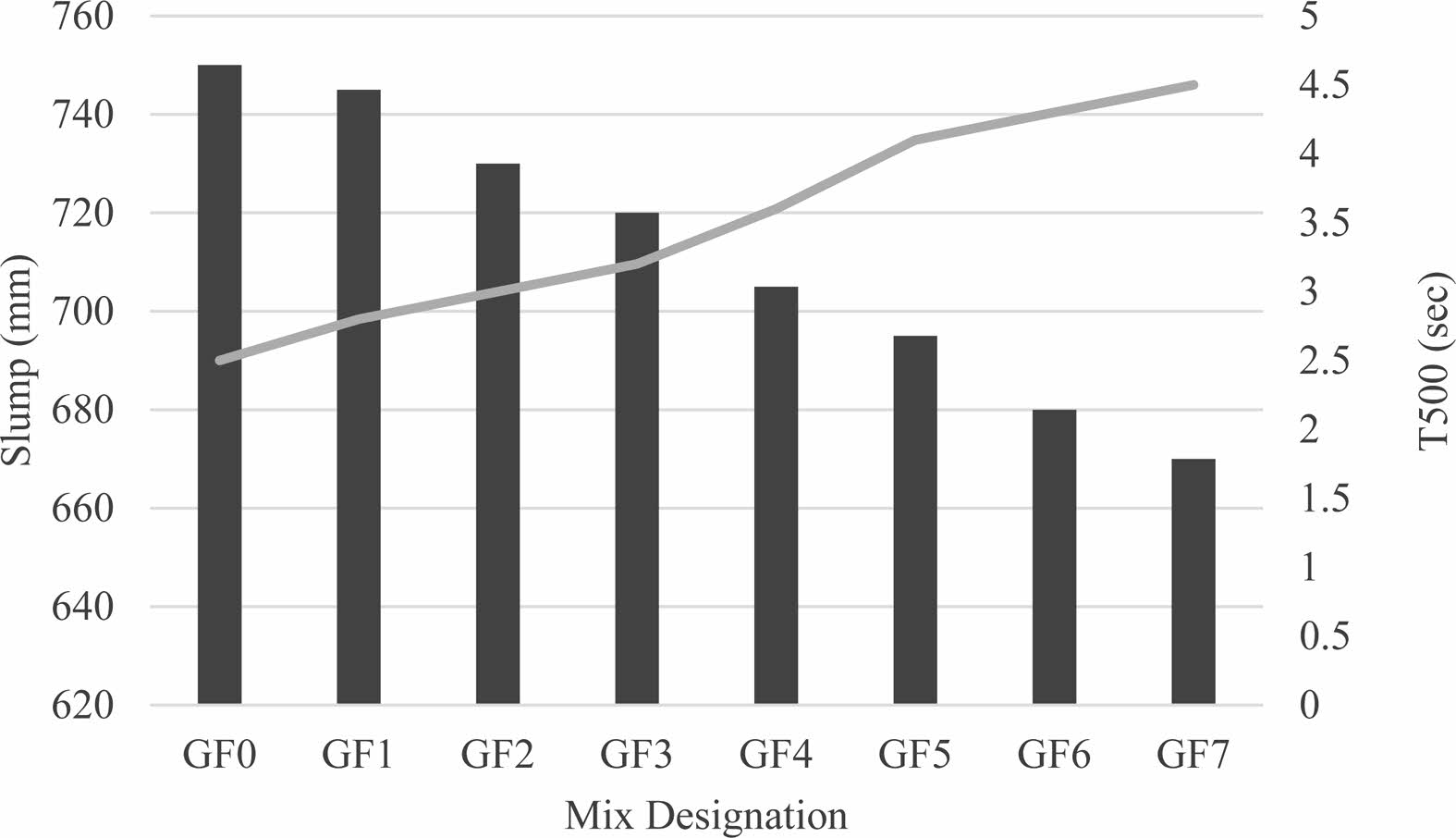
|
Fig. 7 Slump of GFRSCC. |
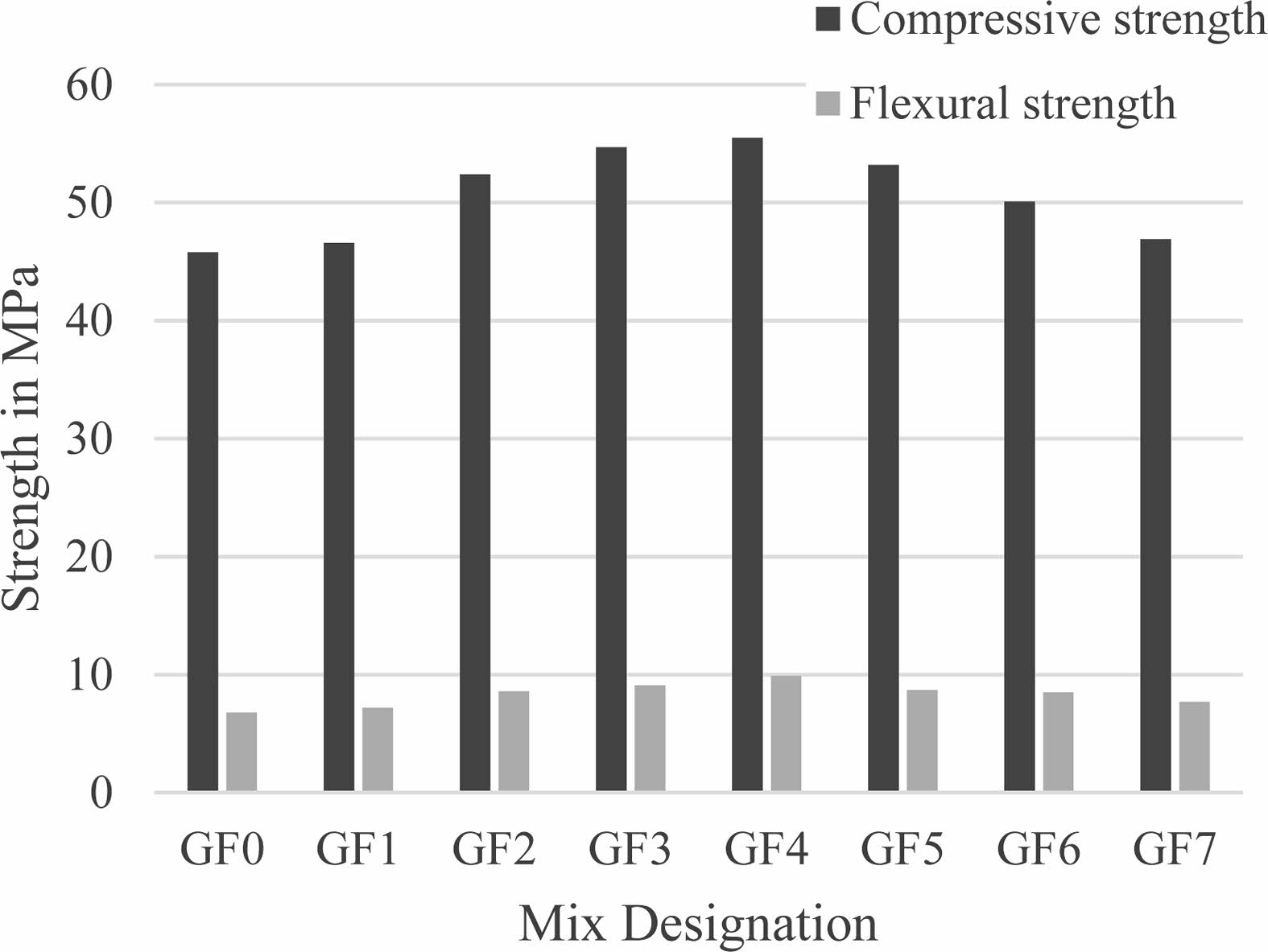
|
Fig. 8 Strength of GFRSCC at 28 days. |
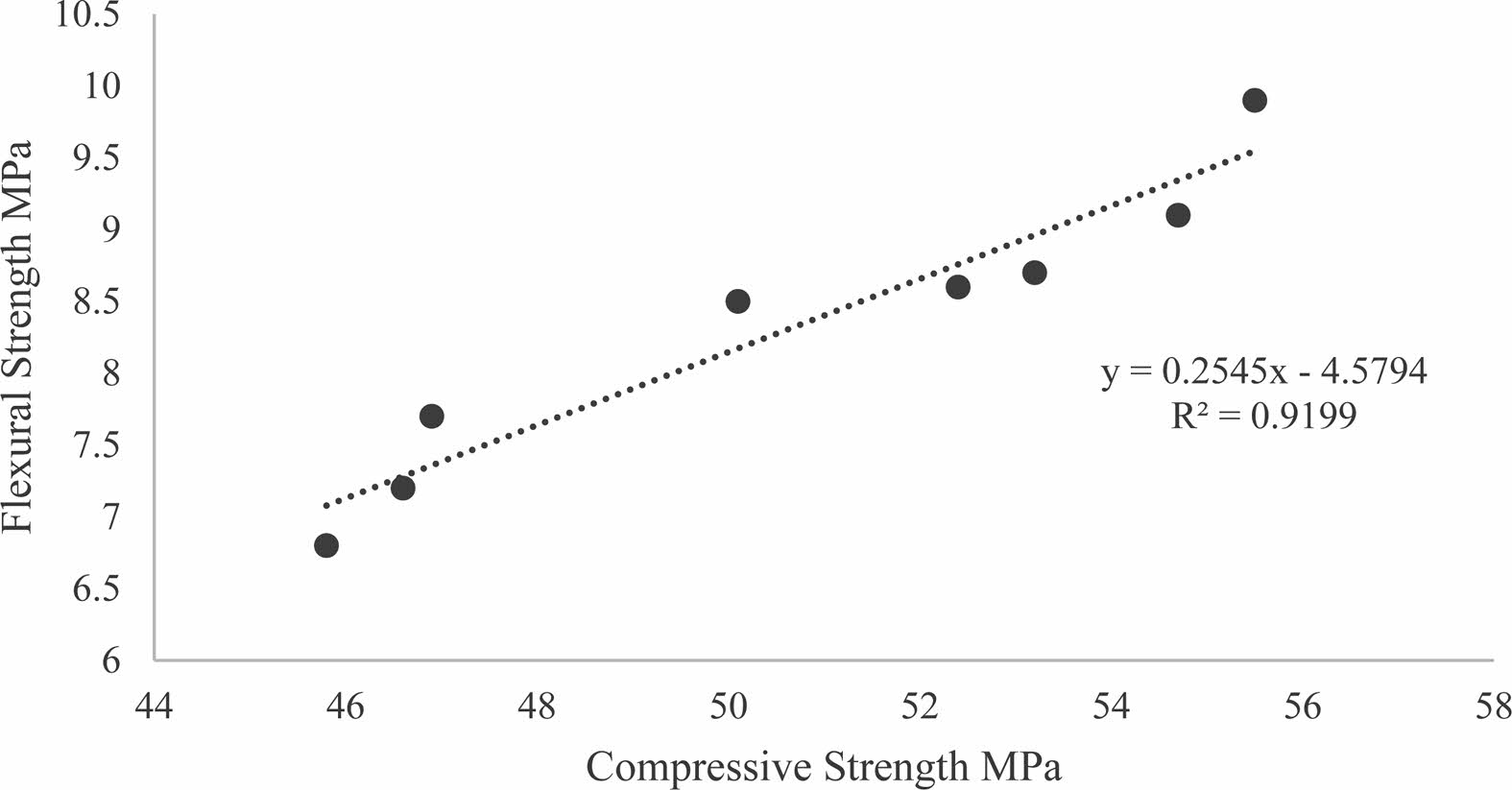
|
Fig. 9 Relation between compressive strength and flexural strength of GFRSCC. |
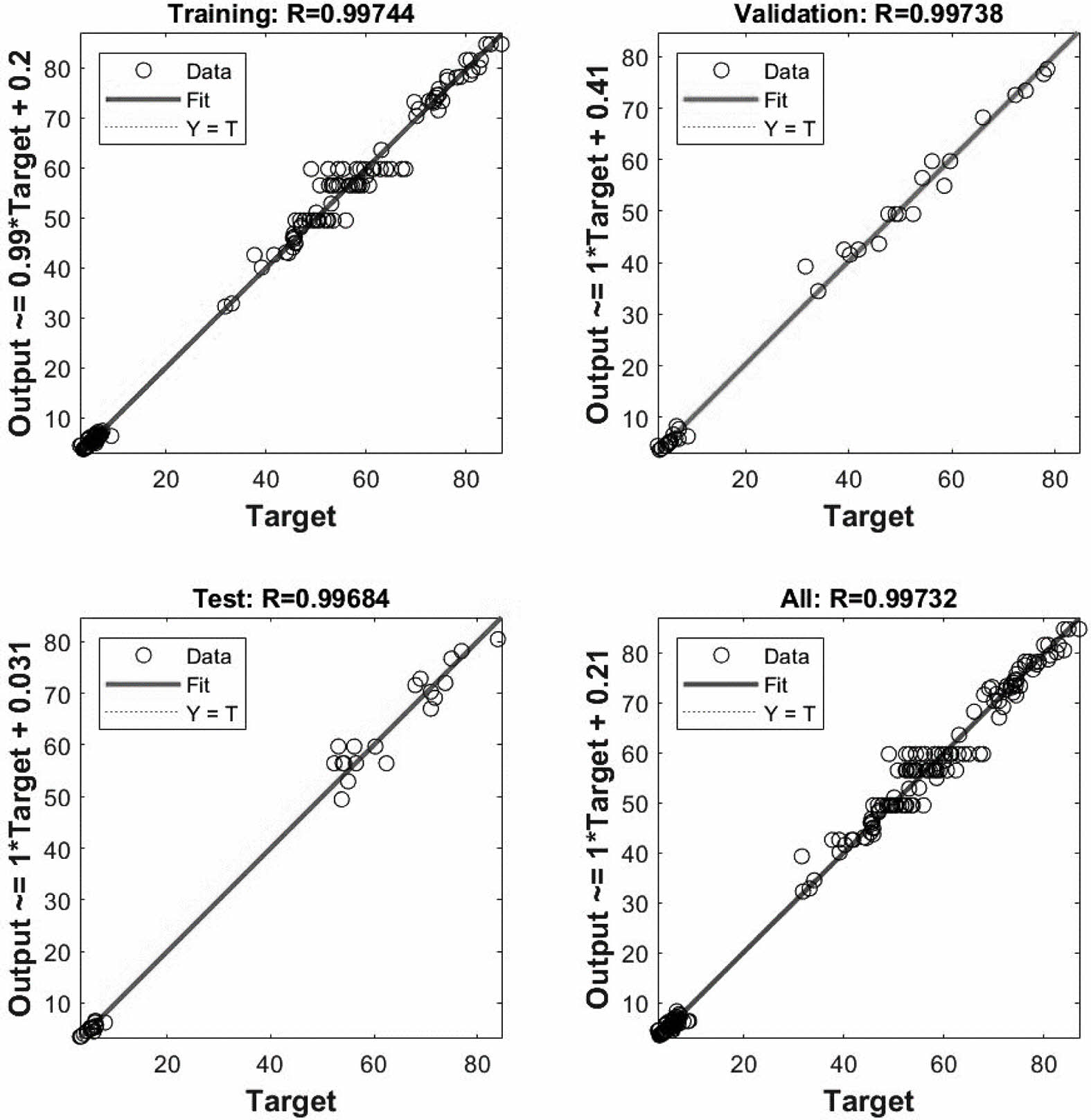
|
Fig. 10 ANN Training, testing, validation |
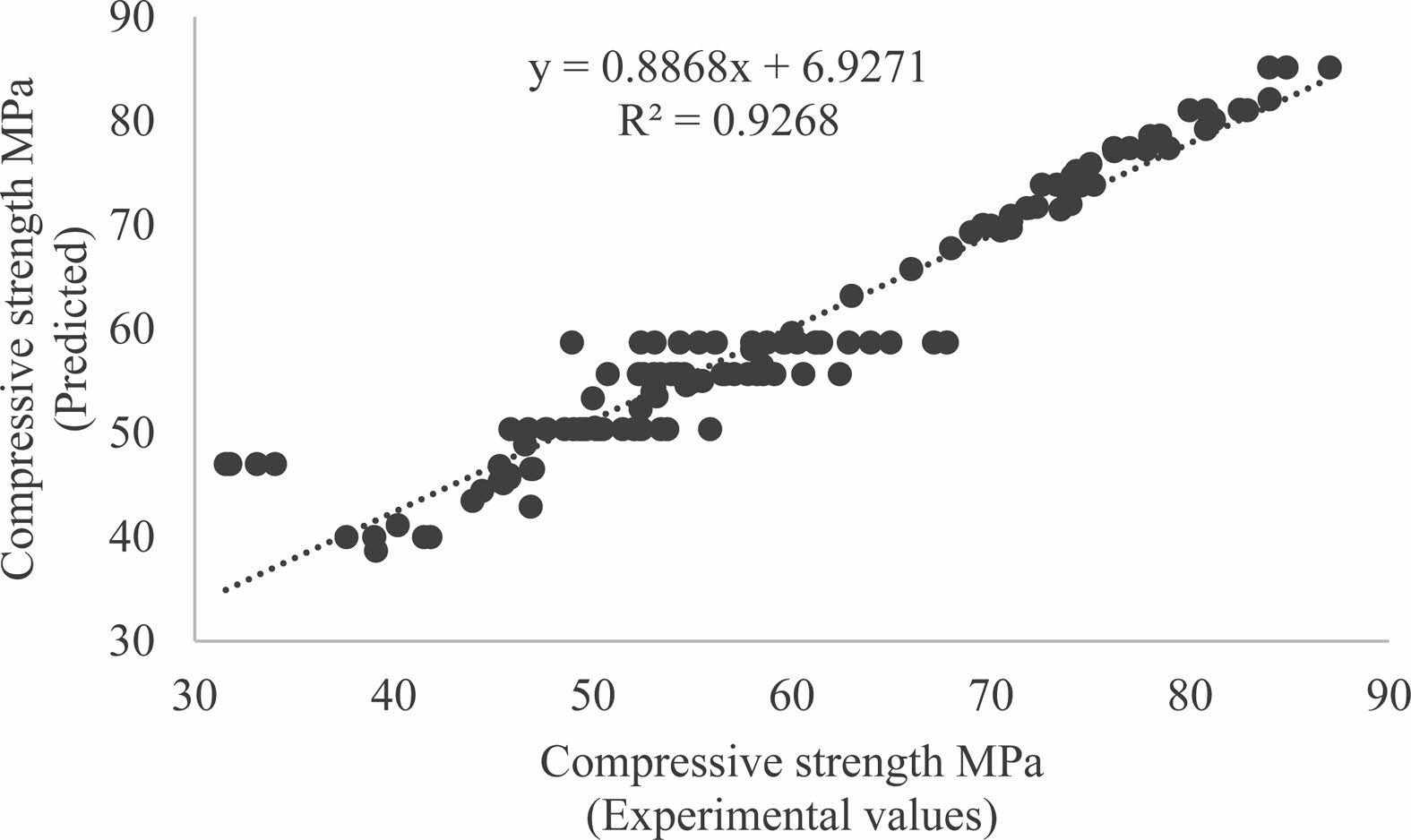
|
Fig. 11 Experimental and predicted compressive strength. |
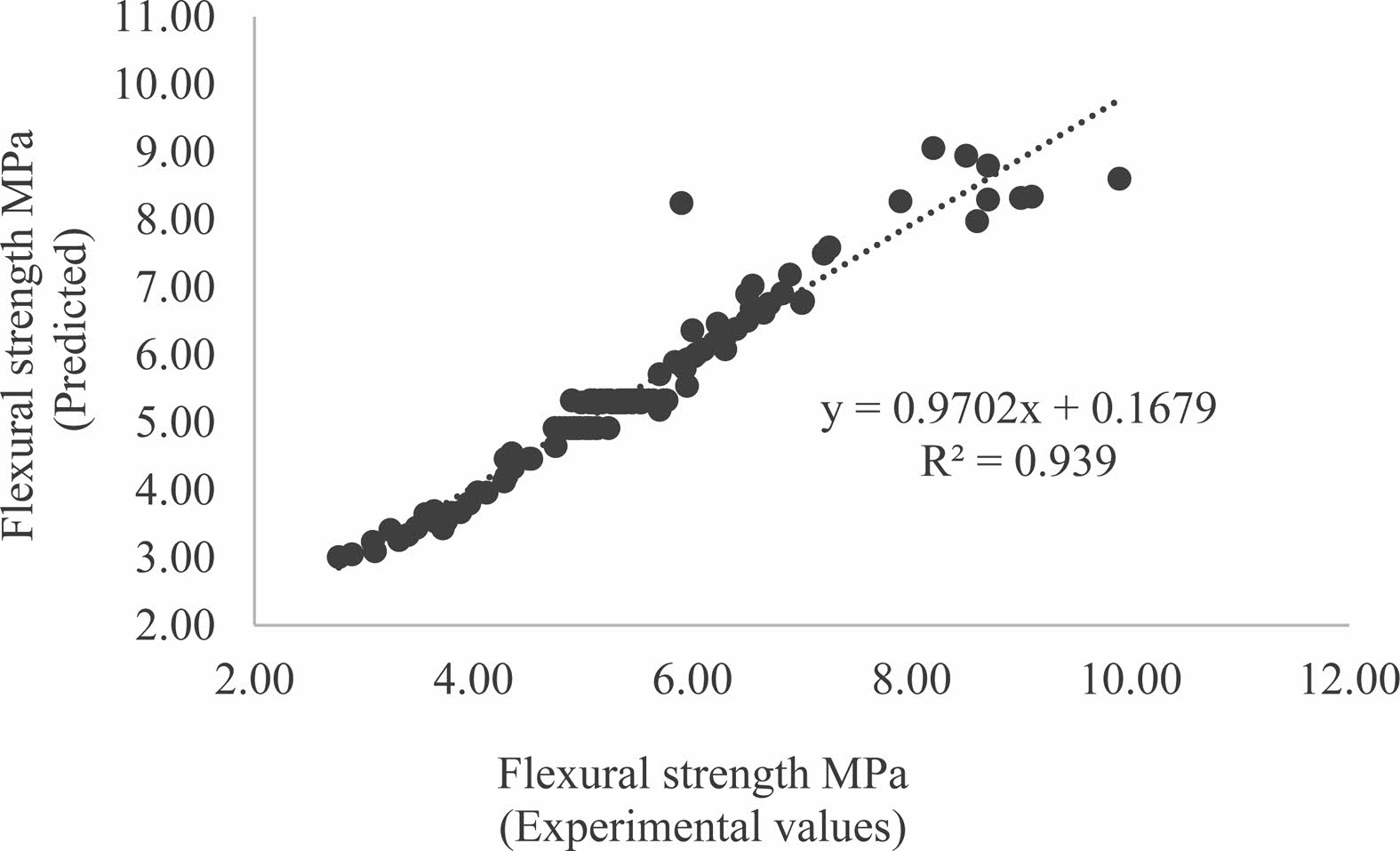
|
Fig. 12 Experimental and predicted flexural strength. |
The novel methodology of utilizing Artificial Neural Network for predicting the compressive strength and flexural strength of concrete with the addition of glass fibres is presented along with the experimental work conducted.
The experimental work was conducted to evaluate the compressive strength and flexural strength of self-compaction concrete with 0.1%-0.7% of glass fibres, with the increment of 1%.
The SCC was designed and cast as per EN guidelines.
The fresh and hardened properties of concrete show better result up to 0.4% of glass fibre content and shows a decreasing trend for higher percentages of fibre content.
A dataset of 128 samples collected was used to predict the output variables such as compressive strength and flexural strength of SCC with glass fibres.
The mathematical modelling was deployed using ANN in MATLAB 2020 by adopting the Levenberg algorithm.
The statistical indicators such as R2 and RMSE found for the developed ANN model reveal that, the results are obtained with high accuracy.
ANN methodology is a suitable tool for predicting the strength of self-compaction concrete with different percentages of glass fibres.
- 1. B.W. Jo, M.A. Sikandar, Z. Baloch, A. Naseer, N. Jan, and Q. Jamal, J. Ceram. Process. Res. 19 (2018) 171-178.
- 2. J.O. Park, J.C. Lee, and S.H. Lee, J. Ceram. Process. Res. 17 (2016) 930-936.
- 3. A.A.M. Fazli et al., J. Ceram. Process. Res. 21 (2020) 667-682.
-

- 4. H.Y. Kim, B.S. Chun, T.H. Park, and J.S. Ryou, J. Ceram. Process. Res. 12 (2011) 202-206.
- 5. Z. Lin and T. Kishi, J. Ceram. Process. Res. 16 (2015) 98s-103s.
- 6. Y.R. Atewi, M.F. Hasan, and E. Güneyisi, Constr. Build. Mater. 226 (2019) 993 -1005.
-

- 7. Y. Heoa and K. Kimb, J. Ceram. Process. Res. 16 (2015) 28-32.
- 8. D. Han, K.M. Kim, G.C. Lee, J.G. Choi, and G.T. Koh, J. Ceram. Process. Res. 16 (2015) s56-s62.
- 9. J.H. Haido, B.A. Tayeh, S.S. Majeed, and M. Karpuzcu, Constr. Build. Mater. 268 (2021) 121725.
-

- 10. L. Gao, A. Adesina, and S. Das, Constr. Build. Mater. 302, (2021) 124161
-

- 11. Z. Algin and M. Ozen, Constr. Build. Mater. 186 (2018) 678-685.
-

- 12. K. Poongodi, P. Murthi, and R. Gobinath, Mater. Today Proc. 39 (2020) 131-136.
-

- 13. A.M. Saba et al., J. Mater. Res. Technol. 12 (2021) 1380-1390.
-

- 14. I. Ferdosian and A. Camões, Cem. Concr. Compos. 121 (2021) 1-12.
-

- 15. N. Li et al., J. Build. Eng. 38 (2021).
- 16. V. Quiceno Pérez, D. Cotes Prieto, and L.E. Zapata Orduz, Eng. Fract. Mech. 246 (2020) 1-16.
-

- 17. M. Mastali, A. Dalvand, and A.R. Sattarifard, J. Clean. Prod. 124 (2016) 312-324.
-

- 18. Y.R. Atewi, M.F. Hasan, and E. Güneyisi, Constr. Build. Mater. 226 (2019) 993-1005.
-

- 19. S. Ahmad, A. Umar, and A. Masood, Procedia Eng. 173 (2017) 807-813.
-

- 20. V.R. Sivakumar, O.R. Kavitha, G.P. Arulraj, and V.G. Srisanthi, Appl. Clay Sci. 147 (2017) 123-127.
-

- 21. H.S. Lee and K.H. Sho, J. Ceram. Process. Res. 19 (2018) 105-110.
- 22. G.M. Sadiqul Islam, M.H. Rahman, Nayem Kazi, Int. J of Sus. Built Env. 6 (2017) 37-44.
-

- 23. N. Nezafati, F. Moztarzadeh, and S. Hesaraki, J. Ceram. Process. 11 (2010) 367-371.
- 24. M. Congro et al., Constr. Build. Mater. 303 (2021).
-

- 25. V.S. Koneru and V.G. Ghorpade, Mater. Today Proc. 26 (2020) 1238-1244.
-

- 26. P.O. Awoyera, M.S. Kirgiz, A. Viloria, and D. Ovallos-gazabon, Integr. Med. Res. 9 (2020) 9016-9028.
-

- 27. D. Nasr, B. Behforouz, P. Rezaei, S. Afzali, and B. Zehtab, Constr. Build. Mater. 229 (2019) 116888.
-

- 28. M.A. Yaman, M.A. Elaty, and M. Taman, Alexandria Eng. J. 56 (2017) 523-532.
-

- 29. H. Mashhadban, S. Soleimani, and M. Ali, Constr. Build. Mater. 119 (2016) 277-287.
-

- 30. K.B. Ramkumar, K.R.P.R, N. Ahmmad, and M. Jegan, Constr. Build. Mater. 261 (2020) 120215.
-

- 31. Q.Y. Wen, H.W. Zhang, Q.H. Yang, and P.X. Zhang, J. Ceram. Process. Res. 9 (2008) 393-397.
- 32. M. Uysal and H. Tanyildizi, Constr. Build. Mater. 25 (2011) 4105-4111.
-

- 33. Indian Standards, No. IS-383 (2016).
- 34. British Standards, No. BS-EN-12350-1 (2009).
- 35. A. Reza and T. Fard, Magazine of Civil Engineering, 2 (2016).
- 36. N. Guruvignesh and K. Priyanka, Int. J. Sci. Res. Multi. Stu. 6 (2020) 17-20.
- 37. V.R. Sivakumar, O.R. Kavitha, G.P. Arulraj, and V.G. Srisanthi, Appl. Clay Sci. 147 (2017) 123-127.
-

- 38. S.L. Hake, S.S. Shinde, P.K. Bhandari, P.R. Awasarmal, and B.D. Kanawade, Web of Cof. 170 (2020) 1-6.
- 39. T. Jeevetha, S. Vijayashanthy, A. Sivakumar, and N.B. Singh, Mater. Today Proc. 45 (2021) 708-712.
-

- 40. Y.R. Atewi, M.F. Hasan, and E. Güneyisi, Constr. Build. Mater. 226 (2019) 993-1005.
-

- 41. S. Ahmad, A. Umar, and A. Masood, Procedia Eng. 173 (2017) 807-813.
-

- 42. S. Ahmad and A. Umar, J. Build. Eng. 17 (2018) 65-74.
-

- 43. S. Jagalur, P. Parasivamurthy, V. Ram, and B.R. Arun, Mater. Today Proc. (2021).
-

- 44. M. Mastali, A. Dalvand, and A.R. Sattarifard, J. Clean. Prod. 124 (2016) 312-324.
-

- 45. A.P. Senthil Kumar, S. Yuvaraj, and S. Janaki, J. Ceram. Process. Res., 21 (2020) 217-225.
-

- 46. N.M. Krishna, M. Selvaraj, A. Kulandaivel, and S.L. Kumar, J. Ceram. Process. Res. 23 (2022) 656-665.
-

 This Article
This Article
-
2022; 23(6): 806-816
Published on Dec 31, 2022
- 10.36410/jcpr.2022.23.6.806
- Received on Mar 26, 2022
- Revised on Jul 1, 2022
- Accepted on Jul 21, 2022
 Services
Services
- Abstract
introduction
experimental investigation
modelling the strength properties of gfrscc
results and discussions
conclusion
- References
- Full Text PDF
Shared
 Correspondence to
Correspondence to
- Balasubramaniam N
-
Assistant Professor, Department of Civil Engineering, Jansons Institute of Technology, Coimbatore, India
Tel : +91-9790562607 - E-mail: balasubramaniamcivil@yahoo.co.in






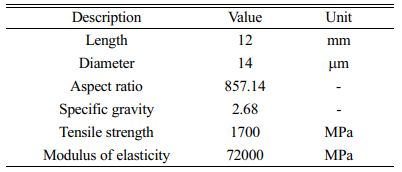



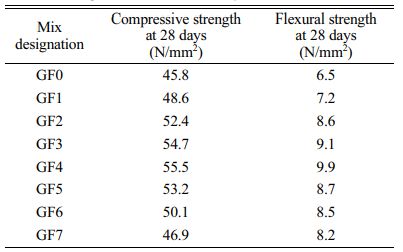

 Copyright 2019 International Orgranization for Ceramic Processing. All rights reserved.
Copyright 2019 International Orgranization for Ceramic Processing. All rights reserved.